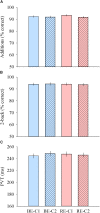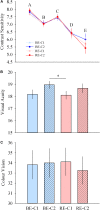Dynamics of Non-visual Responses in Humans: As Fast as Lightning?
- PMID: 30890907
- PMCID: PMC6411922
- DOI: 10.3389/fnins.2019.00126
Dynamics of Non-visual Responses in Humans: As Fast as Lightning?
Abstract
The eye drives non-visual (NV) responses to light, including circadian resetting, pupillary reflex and alerting effects. Initially thought to depend on melanopsin-expressing retinal ganglion cells (ipRGCs), classical photopigments play a modulatory role in some of these responses. As most studies have investigated only a limited number of NV functions, generally under conditions of relatively high light levels and long duration of exposure, whether NV functions share similar irradiance sensitivities and response dynamics during light exposure is unknown. We addressed this issue using light exposure paradigms spectrally and spatially tuned to target mainly cones or ipRGCs, and by measuring longitudinally (50 min) several NV responses in 28 men. We demonstrate that the response dynamics of NV functions are faster than previously thought. We find that the brain, the heart, and thermoregulation are activated within 1 to 5 min of light exposure. Further, we show that NV functions do not share the same response sensitivities. While the half-maximum response is only ∼48 s for the tonic pupil diameter, it is ∼12 min for EEG gamma activity. Most NV responses seem to be saturated by low light levels, as low as 90 melanopic lux. Our results also reveal that it is possible to maintain optimal visual performance while modulating NV responses. Our findings have real-life implications. On one hand, light therapy paradigms should be re-evaluated with lower intensities and shorter durations, with the potential of improving patients' compliance. On the other hand, the significant impact of low intensity and short duration light exposures on NV physiology should make us reconsider the potential health consequences of light exposure before bedtime, in particular on sleep and circadian physiology.
Keywords: EEG; circadian; duration response curve; heart rate; light; non-visual; pupil; temperature.
Figures








Similar articles
-
Temporal characteristics of melanopsin inputs to the human pupil light reflex.Vision Res. 2015 Feb;107:58-66. doi: 10.1016/j.visres.2014.12.001. Epub 2014 Dec 10. Vision Res. 2015. PMID: 25497360 Free PMC article.
-
Melatonin suppression is exquisitely sensitive to light and primarily driven by melanopsin in humans.J Pineal Res. 2019 May;66(4):e12562. doi: 10.1111/jpi.12562. Epub 2019 Mar 1. J Pineal Res. 2019. PMID: 30697806
-
Melanopsin and Cone Photoreceptor Inputs to the Afferent Pupil Light Response.Front Neurol. 2019 May 22;10:529. doi: 10.3389/fneur.2019.00529. eCollection 2019. Front Neurol. 2019. PMID: 31191431 Free PMC article.
-
Circadian Photoentrainment in Mice and Humans.Biology (Basel). 2020 Jul 21;9(7):180. doi: 10.3390/biology9070180. Biology (Basel). 2020. PMID: 32708259 Free PMC article. Review.
-
[Pupil and melanopsin photoreception].Nippon Ganka Gakkai Zasshi. 2013 Mar;117(3):246-68; discussion 269. Nippon Ganka Gakkai Zasshi. 2013. PMID: 23631256 Review. Japanese.
Cited by
-
Sleep and circadian phenotype in people without cone-mediated vision: a case series of five CNGB3 and two CNGA3 patients.Brain Commun. 2021 Jul 18;3(3):fcab159. doi: 10.1093/braincomms/fcab159. eCollection 2021. Brain Commun. 2021. PMID: 34447932 Free PMC article.
-
Twenty-four-hour rhythmicities in disorders of consciousness are associated with a favourable outcome.Commun Biol. 2023 Nov 29;6(1):1213. doi: 10.1038/s42003-023-05588-2. Commun Biol. 2023. PMID: 38030756 Free PMC article.
-
Light Modulation of Human Clocks, Wake, and Sleep.Clocks Sleep. 2019 Mar;1(1):193-208. doi: 10.3390/clockssleep1010017. Epub 2019 Mar 13. Clocks Sleep. 2019. PMID: 32342043 Free PMC article.
-
How to Report Light Exposure in Human Chronobiology and Sleep Research Experiments.Clocks Sleep. 2019 Jul 1;1(3):280-289. doi: 10.3390/clockssleep1030024. Epub 2019 Jun 26. Clocks Sleep. 2019. PMID: 31281903 Free PMC article.
-
Longitudinal association between sleep features and refractive errors in preschoolers from the EDEN birth-cohort.Sci Rep. 2021 Apr 27;11(1):9044. doi: 10.1038/s41598-021-88756-w. Sci Rep. 2021. PMID: 33907290 Free PMC article.
References
LinkOut - more resources
Full Text Sources
Research Materials

